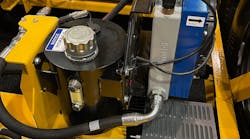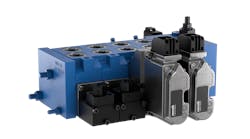A New Approach to Hydraulic Reservoir Designs
Hydraulic reservoirs play an important role in hydraulic systems as they store fluid as well as aid with heat dissipation and fluid conditioning. However, they are often oversized which can cause design challenges for heavy equipment manufacturers.
Price Engineering’s Cyclone Hydraulic Reservoir looks to overcome this by offering a more compact option without compromising fluid flow or other desired performance aspects.
“Historically, the hydraulic reservoir is two to three times the size of the gpm (gallons per minute) of the [hydraulic system’s] pump,” said Tom Price, President, Price Engineering, a SunSource Company, in an interview with Power & Motion. “If your pump was 20 gpm, you had a 40 or 60 gal. reservoir.”
This sizing convention has led to use of larger reservoirs over the years and increased space claim in machines. Price said real estate in mobile equipment is becoming increasingly important to OEMs as they look to put more value-add technologies onto their machines as well as components for meeting emissions regulations.
By instead using a smaller option like Cyclone, OEMs can overcome these space constraint challenges and achieve additional benefits as well.
Advantages of Using Smaller Hydraulic Reservoirs
According to Price, the Cyclone Reservoir is physically about 10 times smaller than the traditional 20-gal. versions mounted on many machines. Not only does this reduce the amount of space required for the reservoir but also overall machine weight.
Reducing machine weight can lead to efficiency improvements, another aspect which is becoming increasingly important to heavy equipment manufacturers as it can help to reduce fuel costs for customers as well as aid with efforts to lower emissions. This will also benefit development of hybrid- and full-electric machines where weight and efficiency are key design criteria.
With the reservoir’s smaller size also comes the ability to use less oil. A 20 gpm Cyclone requires only 1 gal. of oil said Price, providing further weight savings as well as reduced costs for end-use customers. Hydraulic oil is not getting any cheaper, he said. “High quality and biodegradable oils are getting quite expensive. So, to be able to save [money] is important.”
OEMs can benefit from use of the reservoir as well. Besides aiding their machine designs, Cyclone’s smaller size reduces the amount of inventory space required at a manufacturing facility. The smaller size and weight of the hydraulic reservoir can also help to lower shipping costs.
Cyclone Prevents Air and Oil from Mixing
In addition to its smaller size, the technology used within the Cyclone Hydraulic Reservoir can also benefit machine owners.
Unlike a typical reservoir, Cyclone features a cylindrical shape and uses centrifugal force to remove air from hydraulic fluids. Doing so helps to ensure optimized system and overall machine performance.
Price explained that air is typically dissolved in these fluids but once oil starts pumping through the hydraulic system and pressure is created, air bubbles can form. As hydraulic oil flows through the system, it flows through corners and orifices which could cause the formation of vacuums, leading air to be pulled out of the oil and bubbles to form – leading to potential performance issues.
“I always like to say a clear jar of oil looks like a good lager beer,” he said. “However, when you get an oil that has been emulsified over and over it comes back looking like milk.”
It is important to avoid air and oil mixing to a point where the hydraulic oil looks like milk. This means oxidation has occurred which can cause compressibility problems, cavitation and other issues that negatively impact the performance of the hydraulic system and the machine.
This is an issue all heavy equipment manufacturers recognize occurs and want to solve said Price. However, the traditional solution has been to use larger reservoirs which allow the air bubbles to float to the top of the hydraulic reservoir tank.
Cyclone, on the other hand, uses a spinning technique to create centrifugal forces which push the heavier oil to the outside wall of the reservoir for use in the hydraulic system. The lighter air bubbles are kept at the center by a cyclone effect and pushed to the air space above the hydraulic fluid. The air is released out of the reservoir into the atmosphere through a filler/breather cap, ensuring the fluid continues to look like a lager beer and the hydraulic system performs as desired.
READ MORE: Fundamentals of Hydraulic Reservoirs
Construction Equipment Manufacturer Benefits from Smaller Hydraulic Reservoir
The Cyclone Reservoir can be used in a variety of mobile and stationary applications. Etnyre, a manufacturer of asphalt road construction equipment, is one of the many OEMs which has seen the benefits provided by the device.
A small tow-behind machine was the first onto which Etnyre integrated the reservoir. “We needed to find a way to simplify our design and reduce weight of the machine,” said Randy Tattershall, Director of RES Sales, Etnyre, in an interview with Power & Motion. “Space constraints are always a challenge, especially on smaller machines.”
After conducting research on the Cyclone technology, Tattershall said the company did some prototyping with it and was impressed by the results. “We put it on a machine out in the field and had no issues with it,” he said. “Now all our machines of that type are using the reservoir.”
Tattershall said use of the hydraulic reservoir helped to reduce space claim as well as oil used in the machine. The latter helps with maintenance as there is less oil that needs to be disposed of, he said. “It is very environmentally friendly in that regard. That’s a big movement for our company to try and be as environmentally friendly in our designs and applications as possible.”
When integrating the Cyclone Reservoir into its machine, Tattershall said Etnyre found it needed to add a small heat exchanger as well to help with temperature displacement as there was no longer the volume of oil in the machine to aid with this as there was with previous reservoirs. “But it was a modest expense and not really an issue as we moved forward with the design,” he explained.
One aspect he said should be top of mind when integrating the Cyclone Hydraulic Reservoir is ensuring it is sized appropriately for the flow required of the application. Designers must understand the hydraulic flow needs of their machine and be careful to choose the right size reservoir to meet performance requirements. Working together with the Price Engineering team can help with this, he said.
Tattershall said it is important for machine designers like Etnyre to embrace newer technologies, especially those which can provide some environmental benefits like Cyclone does with its reduced oil use. While machine performance may not be improved simply because the hydraulic reservoir was changed, the space savings it enables offers that possibility. “It gives us an opportunity to have more space and maybe do some other machine enhancements because that footprint and weight are not tied up by a large reservoir,” he said.
Etnyre is currently using the Cyclone Reservoir on a few of its smaller machine applications and is “very happy with the results,” said Tattershall. There has been a need to educate customers on the benefits a smaller reservoir can provide, particularly in regard to the cost savings which can be achieved through reduced oil use, but so far it has been positively received he said.







